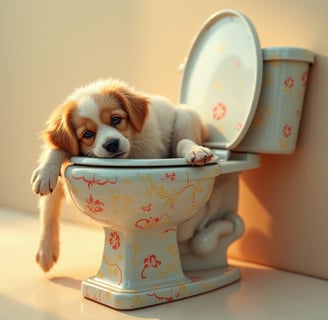I believe in educating dog owners about their breed, unlocking new levels of understanding, and taking that exciting next step together!
The Ultimate Guide to Scheduled Potty Training for Your Dog
Scheduled potty training is your secret weapon for turning your dog into a potty-trained pro—and keeping your floors puddle-free! This method thrives on consistency and structure, syncing with your dog’s natural rhythms. Feed your pup on a regular schedule to set the timer for their bathroom needs. Add predictable potty breaks after meals, naps, and playtime, and make a single outdoor spot their royal potty throne. Introduce a command like “Go potty,” reward every success with treats or belly rubs, and watch your dog nail the routine. Adjust the schedule as they grow, clean up accidents thoroughly (they’ll sniff it out!), and remember to stay patient. With a dash of humor, a sprinkle of praise, and a lot of consistency, you’ll have a potty-trained pup who’s the star of the backyard. Your carpets (and your sanity) will thank you!
POTTY TRAINING
Tiffany Sandquist
4 min read


Potty Training Your Dog Using the Scheduled Method
Potty training your dog: a mission that feels like trying to teach a squirrel how to drive a car. But don’t worry, we’re here to help! Among all the techniques you could try, scheduled training is like the trusty GPS that keeps you from getting lost on the road to a potty-trained pup. By using the natural rhythms of your dog’s body, this method creates a routine that’s easier for both you and your four-legged companion. Whether your dog is a bouncy puppy or a distinguished senior, scheduled potty training can help them develop habits that will have you both wagging with joy.
In this post, we’re going to break down scheduled potty training, step by step, so you’ll have all the tools you need to succeed. Get ready to become the potty whisperer your dog needs!
Why Scheduled Training Works
Dogs thrive on consistency and routines. Scheduled potty training takes advantage of their need for structure and turns it into a superpower. Here’s why this method works:
Predictability: Dogs’ digestive systems are more predictable than your favorite soap opera. A consistent schedule helps you anticipate when they need to go.
Habit Building: Like humans hitting the gym every Monday (or at least planning to), regular potty breaks help cement good habits.
Fewer Accidents: By preempting your dog’s bathroom needs, you reduce the chances of finding surprise puddles on your floor.
Trust Builder: A predictable routine shows your dog that you’ve got their back—and their bladder.
Steps to Implement Scheduled Potty Training
1. Establish a Feeding Schedule
Dogs are like clockwork when it comes to eating. Feed them at the same time every day, and you’ll see a predictable pattern emerge faster than you can say “potty break!”
Feed puppies 3-4 times daily (because tiny tummies = frequent pit stops). Adult dogs can eat twice a day.
Stick to a schedule—something like 7:00 AM, 12:00 PM, and 6:00 PM works great.
Remove the food bowls after 15-20 minutes, so your pup learns to eat when it’s mealtime (and not when they’re bored).
A consistent feeding routine is like setting a timer for your dog’s bathroom breaks—it’s that simple!
2. Create a Potty Break Schedule
Think of this as your dog’s personal bathroom calendar. Regular potty breaks help them connect the dots between "now’s the time" and "outside’s the place." Here’s a sample breakdown:
First thing in the morning: Wake up, stretch, potty. (Them, not you.)
After meals: Puppies need to go within 5-15 minutes of eating; adults may take a little longer.
After naps: Dreams about chasing squirrels apparently wake up their bladders.
After playtime: All that zooming around gets things moving.
Before bedtime: One last trip to ensure a peaceful night.
If you’ve got a puppy, be prepared for extra breaks every 1-2 hours. They’re still learning to hold it together—literally.
3. Use a Designated Potty Spot
Consistency is key, so pick one outdoor spot and make it your dog’s throne (minus the gold trim). Here’s why:
The familiar smell of their previous potty trips says, “This is the spot!”
Fewer distractions = better focus. (Looking at you, neighbor’s cat.)
Your lawn will thank you for the containment strategy.
4. Introduce a Command
Potty training commands are like cheat codes for your dog’s brain. Try something simple like “Go potty” or “Do your business.” Here’s how to make it stick:
Say the command as soon as they start going. It’s like narrating their big moment.
Stick to the same phrase every time.
Before you know it, your dog will respond to the command like a pro—even in new environments.
5. Reward Good Behavior
Let’s be honest: everyone loves a reward, and your dog is no different. Positive reinforcement is the golden ticket here. Try these options:
Hand out a tasty treat right after they go. (Think of it as a doggy high-five.) My dog loves these #ad https://amzn.to/3DBQmQu
Go overboard with praise: “Who’s the best dog? YOU ARE!”
Playtime or belly rubs work wonders too.
Be consistent with rewards, especially in the early stages. Over time, you can phase out treats and stick to praise (but treats are never a bad idea). My dog loves
6. Adjust the Schedule as Needed
As your dog grows, so do their bladder muscles. Please pay attention to their cues and tweak the schedule as needed. Common signs they need to go include:
Sniffing the floor like a detective on a case.
Circling or pacing like they’re choreographing a dance.
Whining or giving you the "I gotta go" eyes.
Sample Potty Training Schedule
Here’s a day in the life of a potty-trained pup:
6:00 AM: Morning potty break. (Rise and shine!)
7:00 AM: Breakfast, followed by a potty break.
9:00 AM: Mid-morning potty break.
12:00 PM: Lunch, followed by—you guessed it—a potty break.
3:00 PM: Afternoon potty break.
6:00 PM: Dinner, then a potty break.
9:00 PM: Evening potty break.
10:30 PM: Final potty break. Sweet dreams!
For puppies under 12 weeks, throw in a middle-of-the-night potty run. It’s temporary, we promise.
Tips for Success
Be Patient
Your dog isn’t plotting to ruin your carpet; they’re learning. Stay calm, stay consistent, and leave the drama for Netflix.
Monitor Water Intake
Keep tabs on their water bowl, especially in the evening—less water before bedtime = fewer midnight potty emergencies.
Clean Accidents Thoroughly
Accidents happen. Clean up with an enzymatic cleaner to remove any lingering smells. (Your dog’s nose is better than yours, trust us.) I used Rocco & Roxy, it works great, click here to get some today…#ad https://amzn.to/3BFGIMe
Celebrate Small Wins
Every successful potty trip is a victory. To keep morale high, throw a mini party (treats and belly rubs included).
Common Challenges and How to Fix Them
Frequent Accidents
If you’re still finding puddles:
Are you taking your dog out often enough?
Is the feeding schedule consistent?
Are distractions sabotaging potty time?
Reluctance to Go Outside
If your dog’s giving you the "I’d rather not" face:
Use a covered area if it’s raining or snowing.
Gradually introduce them to noisy or busy environments.
Make the potty spot feel safe and inviting.
Health Issues
When in doubt, check with a vet. Sometimes frequent accidents mean there’s an underlying issue.
Final Thoughts
Scheduled potty training is your ticket to a cleaner home and a happier dog. With consistency, rewards, and a little patience, you’ll turn potty time into a smooth routine. Remember, every accident is just a step on the learning curve. Keep going—you’ve got this!
Now go forth and potty-train like a pro. Your carpets will thank you.

Sit Happens Here
Transforming lives through dog training excellence.
Contact Us
971-218-9622
© 2024. All rights reserved.
